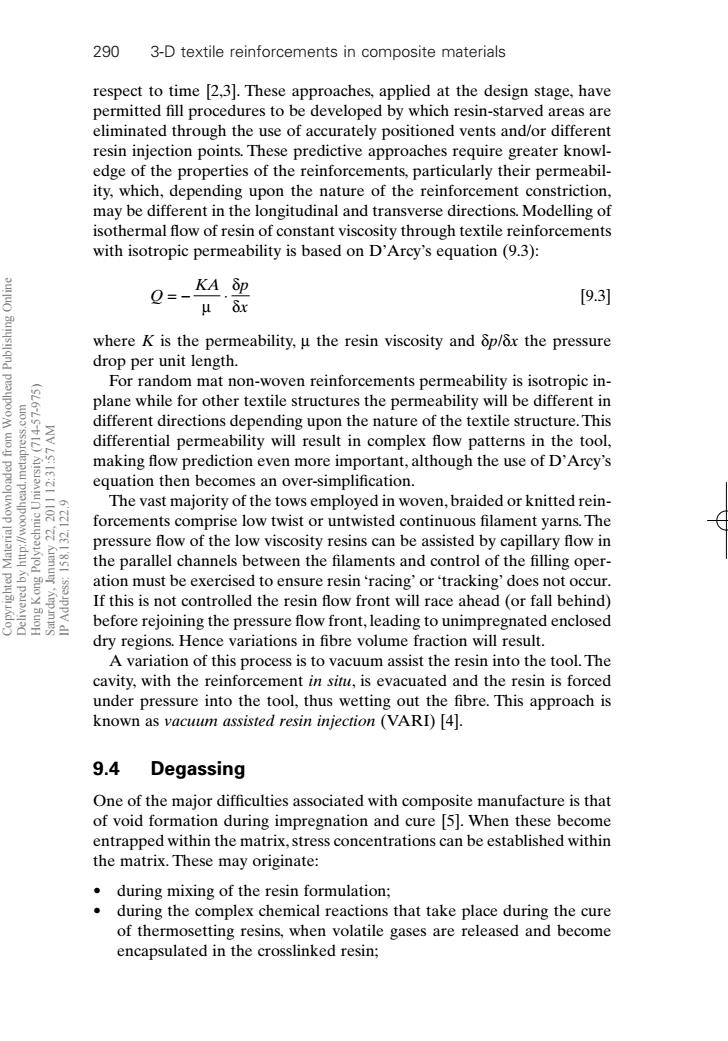正在加载图片...

290 3-D textile reinforcements in composite materials respect to time [2,3].These approaches,applied at the design stage,have permitted fill procedures to be developed by which resin-starved areas are eliminated through the use of accurately positioned vents and/or different resin injection points.These predictive approaches require greater knowl- edge of the properties of the reinforcements,particularly their permeabil- ity,which,depending upon the nature of the reinforcement constriction, may be different in the longitudinal and transverse directions.Modelling of isothermal flow of resin of constant viscosity through textile reinforcements with isotropic permeability is based on D'Arcy's equation(9.3): Q=-KA.ip u 8x [9.3] where K is the permeability,u the resin viscosity and op/ox the pressure drop per unit length. 5 For random mat non-woven reinforcements permeability is isotropic in- pooM plane while for other textile structures the permeability will be different in different directions depending upon the nature of the textile structure.This differential permeability will result in complex flow patterns in the tool, making flow prediction even more important,although the use of D'Arcy's equation then becomes an over-simplification. 着之5 The vast majority of the tows employed in woven,braided or knitted rein- forcements comprise low twist or untwisted continuous filament yarns.The pressure flow of the low viscosity resins can be assisted by capillary flow in the parallel channels between the filaments and control of the filling oper- ation must be exercised to ensure resin'racing'or'tracking'does not occur. If this is not controlled the resin flow front will race ahead (or fall behind) before rejoining the pressure flow front,leading to unimpregnated enclosed dry regions.Hence variations in fibre volume fraction will result. A variation of this process is to vacuum assist the resin into the tool.The cavity,with the reinforcement in situ,is evacuated and the resin is forced under pressure into the tool,thus wetting out the fibre.This approach is known as vacuum assisted resin injection (VARI)[4]. 9.4 Degassing One of the major difficulties associated with composite manufacture is that of void formation during impregnation and cure [5].When these become entrapped within the matrix,stress concentrations can be established within the matrix.These may originate: during mixing of the resin formulation; during the complex chemical reactions that take place during the cure of thermosetting resins,when volatile gases are released and become encapsulated in the crosslinked resin;respect to time [2,3]. These approaches, applied at the design stage, have permitted fill procedures to be developed by which resin-starved areas are eliminated through the use of accurately positioned vents and/or different resin injection points. These predictive approaches require greater knowledge of the properties of the reinforcements, particularly their permeability, which, depending upon the nature of the reinforcement constriction, may be different in the longitudinal and transverse directions. Modelling of isothermal flow of resin of constant viscosity through textile reinforcements with isotropic permeability is based on D’Arcy’s equation (9.3): [9.3] where K is the permeability, m the resin viscosity and dp/dx the pressure drop per unit length. For random mat non-woven reinforcements permeability is isotropic inplane while for other textile structures the permeability will be different in different directions depending upon the nature of the textile structure. This differential permeability will result in complex flow patterns in the tool, making flow prediction even more important, although the use of D’Arcy’s equation then becomes an over-simplification. The vast majority of the tows employed in woven, braided or knitted reinforcements comprise low twist or untwisted continuous filament yarns. The pressure flow of the low viscosity resins can be assisted by capillary flow in the parallel channels between the filaments and control of the filling operation must be exercised to ensure resin ‘racing’ or ‘tracking’ does not occur. If this is not controlled the resin flow front will race ahead (or fall behind) before rejoining the pressure flow front, leading to unimpregnated enclosed dry regions. Hence variations in fibre volume fraction will result. A variation of this process is to vacuum assist the resin into the tool. The cavity, with the reinforcement in situ, is evacuated and the resin is forced under pressure into the tool, thus wetting out the fibre. This approach is known as vacuum assisted resin injection (VARI) [4]. 9.4 Degassing One of the major difficulties associated with composite manufacture is that of void formation during impregnation and cure [5]. When these become entrapped within the matrix, stress concentrations can be established within the matrix. These may originate: • during mixing of the resin formulation; • during the complex chemical reactions that take place during the cure of thermosetting resins, when volatile gases are released and become encapsulated in the crosslinked resin; Q KA p x =- ◊ m d d 290 3-D textile reinforcements in composite materials RIC9 7/10/99 8:32 PM Page 290 Copyrighted Material downloaded from Woodhead Publishing Online Delivered by http://woodhead.metapress.com Hong Kong Polytechnic University (714-57-975) Saturday, January 22, 2011 12:31:57 AM IP Address: 158.132.122.9